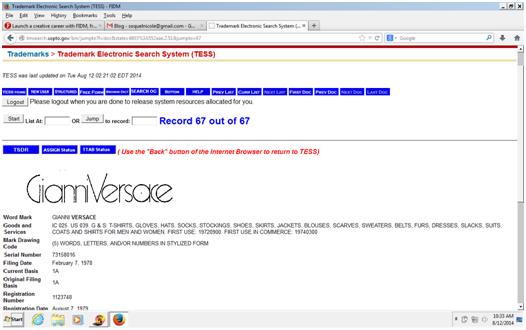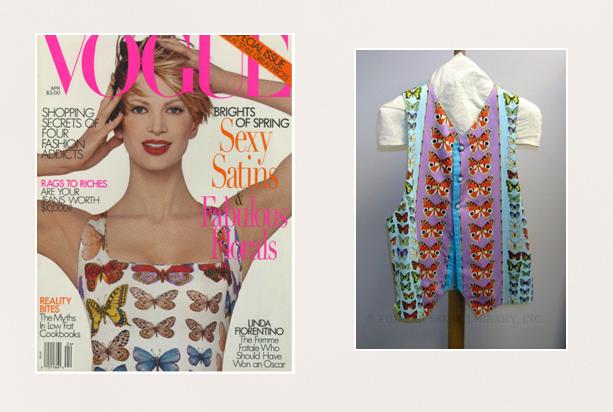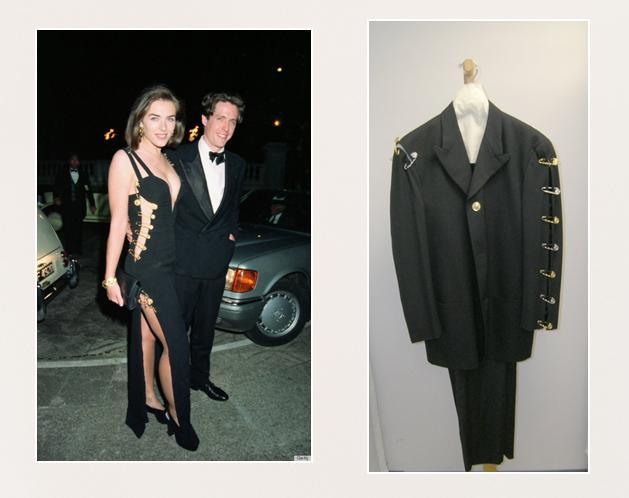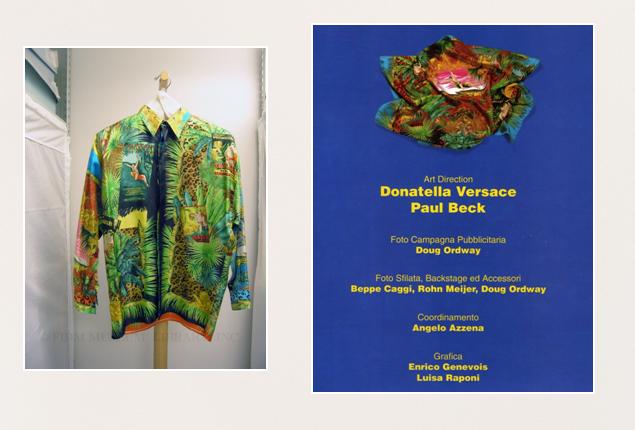Intern Report: The Gianni Versace Menswear Archive, Part II
The interns are on a roll! Last week, we featured intern Rachel Panella's post on working with our extensive collection of Versace menswear. Today, intern Soquel Filice, who also spent her summer working with the Versace Menswear Archive, sheds light on a different aspect of collection research: documenting and dating garments. Thanks for these great tips, Soquel!
**********
“His clothes are often skin tight, low cut, slit high and siren bright. He was among the first to revive the cat suit, to bring back the mini skirt, to show tights worn as pants, and bring out the bustier at night and bead it.”1
Italian designer Gianni Versace left a bold mark on the fashion world with his overtly sexual designs and mixing of prints and fabrics. Versace even said himself, “I think life is nice if you mix everything up.”2 Not only did Versace leave a mark on the world of fashion when he died in 1997, he left a design legacy and a peek into the history of the late 1980s and early 1990s. This summer, I have had the privilege to gain insight into the life and legacy of Versace through processing the Gianni Versace Menswear Archive at FIDM Museum alongside another intern, Rachel Panella.
We were tasked with cataloging, dating, rehousing, describing, and completing an inventory for every piece of this beautiful 1300 piece collection worn by the late Marvin Worth. After Rachel completed her internship, I was assigned with dating each piece in the collection. Although this is my first time dating garments, there are many resources out there that helped me and can help anyone accomplish this task.
An easy way to narrow down the decade that different garments were made in and give context to a collection is the website http://www.uspto.gov/trademarks/index.jsp. This website (recommended by the lovely Rachel Panella) has pictures and dates of registered patents and trademarks for different designers, so it is easy to do a basic search for Versace in the Trademark Electronic Search System or TESS to find different labels that are on a majority of garments in the collection. TESS helped me to narrow down which garments are from the 1980s and which are from the 1990s.

Screenshot from the TESS website.
By far the most helpful tool in dating a vintage collection is having original catalogs from the time period being researched. I was fortunate to have access to Versace menswear catalogs from 1982-1996 in order to research this collection. I found dates for most garments by looking at these catalogs and matching them to the pictures and descriptions that are located in the Museum’s Past Perfect database. Looking for patterns and trends that stand out for each fashion season is an easy way to date garments in a collection. One example from the Versace collection is the Tarzan print themed shirt from the Spring/Summer 1993 catalog. Just by glancing at the pattern and flipping through one of the catalogs, I was easily able to find a date for shirt (pictured below).
This tropical Tarzan print was featured throughout Versace's S/S 1993 collection. Left: Tarzan print silk shirt, Gianni Versace, Italy, Spring/Summer 1993, V2006.890.323, Gift of Joan Worth in memory of Marvin Worth. Right: Image from Spring/Summer 1993 Catalog featuring a Tarzan print silk handkerchief.
Another way to date a vintage garment collection is to use an online database such as Pro Quest Historical Newspapers or the Vogue Archive to look through old advertisements. This was a challenging task for the Versace Archive because the collection I am working with is solely menswear, and Vogue is a womenswear magazine. I did not find it as helpful as I wanted it to be, but I was able to recognize trends in womenswear during different years that helped me to date menswear pieces from the same year. I found a Vogue cover shoot of model Linda Florentino wearing a Versace white butterfly patterned dress from Spring/Summer 1995 and immediately knew that a shirt, tie, and vest in the Versace Menswear Archive dated from that year. Additionally, Elizabeth Hurley’s iconic safety pin dress from the Spring/Summer 1994 collection revealed to me that the white and black safety pin suit jackets in the FIDM Museum collection were from that same year.

April 1995 Vogue cover with model Kristen McMenamy wearing a Versace butterfly print dress. On the right is a Versace man's vest with a similar print (Vest, Gianni Versace, Italy, Spring/ Summer 1995, V2006.890.253, Gift of Joan Worth in memory of Marvin Worth).

Right: Elizabeth Hurley wearing Versace's revealing safety pin dress, 1994. Left: Man's black wool suit with safety pins, Gianni Versace, Italy, Spring/Summer 1994, V2006.890.184AB, Gift of Joan Worth in memory of Marvin Worth.
I could go on and on about all of the different strategies I used to date the Versace Menswear Archive, but for the sake of brevity I will conclude with one last tip: try everything and do your research! Databases, print catalogs, and good old fashioned library books will aid any researcher if he/she knows how to use them and is persistent about trying multiple methods to accomplish a task. When in doubt, ask a librarian for help. Good luck and happy dating!
1 Reed, Julia “Fashion: The Kings of Color: Versace.” Vogue Magazine(September 1, 1990), 542-545, 644.
1 Ibid. 545.
